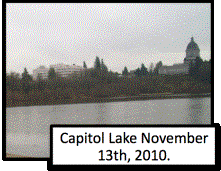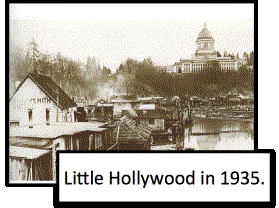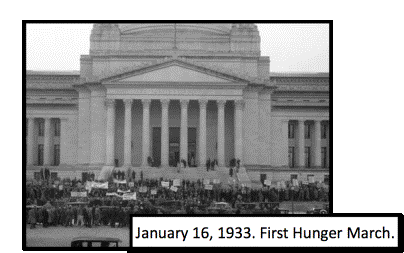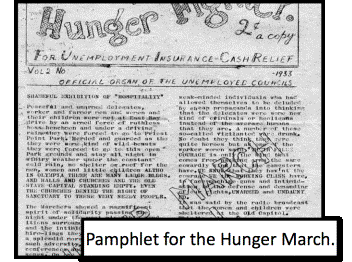It's Not Just The Water: The life and lies of Olympia residents
during the Great Depression Years
By Lora Weed
Herbert Hoover once said, “About the time we can make the ends meet, somebody moves the ends.” The Great Depression caused millions of Americans all over the nation to lose their jobs, homes and in many cases their lives. The severity of the Great Depression differed from state to state but the common factors remain the same, the Great Depression affected more than just those who lived through it shaped America forever.
Historians agree on is that the past cannot be forgotten. Yet Washington State has allowed a gross fabrication of events to be stated as accepted history and has allowed the complete annihilation of what actually occurred. Little Hollywood in Olympia and the Hunger Marchs of 1933 are specific examples of the trials and tribulations that many Americans faced during the Great Depression. It is through research of Olympia during the Great Depression that I am urging a complete renaissance of Olympia’s history to occur.
Every morning you can see elderly couples persisting through their physical ailments in hopes of achieving physical fitness goals. You also see the soccer mom attempting to regain her once beauty contestant worthy body by jogging around listening music on her MP3 player. You might even be able to see a person whose very persona rivals that of any big city. This elusive description is outlines the characters who are regularly seen at Olympia Washington’s Capitol Lake. Today’s Capitol Lake would be unrecognizable to those who resided there nearly eighty years ago because of the vast changes that have occurred including the physical change of the lake.


The 1930s in America marked the beginning of the worst economic downturn that the nation has seen to date, commonly referred to as the Great Depression. The overwhelming poverty that Americans faced forced many Americans to leave the comfort of their middle class homes and relocate into slums. These slums were known as Hoovervilles because of the growing acceptance that Herbert Hoover let America slip into the grip of the Great Depression. Washington State had several Hoovervilles located wherever there was a dense population, including the State Capitol of Olympia.
Olympia’s Hooverville was centrally located in the heart of the town that is presently Capitol Lake. This Hooverville was similar to many across the nation except many were float houses, towed in at high tide and left to squat on the mud flats . Architecturally, the town resembled the essence of the Great depression. The buildings were made of materials found ranging from cardboard to the occasional washed up plank boards. The walkways of Little Hollywood were covered with trash and slime from the moving water. The city within a city is remembered not for the moving structures but by the characters that lived there.

Olympia’s Hooverville was fondly named Little Hollywood. The naming of the town is credited to Ray Hays. Ray Hays names the area Little Hollywood to express the large contrast between the golden paved roads of Hollywood with the slum of Olympia. Ray Hays was the police captain during the depression and is often credited as being of the “old school policemen”. “Little Hollywood was a nest of immigrant lumber and forest workers and every type of character and bum, boomed Hays in a voice that appeared to originate somewhere from his six foot, plus frame. I've taken murderers, robbers, rapists and every type of stinking criminal out of there. There were some bad ones, all right, but as a whole the transients were pretty good old bums." “Good old bums” are still held in high regard even in today’s Olympia although the crimes committed are very different.

The crimes of Little Hollywood ranged from robbery and gambling to violating all aspects of the Volstead Act. The creation and distribution of alcohol was one of the most common pastimes. Although drinking was certainly a problem in the area no deaths were ever accounted for due to drinking. Drinking was not the only problem in the area crime rates rocketing into the late 1930’s. The legacy of Little Hollywood is overshadowed by the crime of the time. The comradery of the residents is forgotten as well as those who never committed any crimes. Even if the people where forgotten the fact that the residents of Little Hollywood were able to survive some of the hardest years in the United States resonates the idea that those who come from Olympia share and over whelming sense of unity something that is shown during the Hunger marches of 1933.
Olympia’s long and dedicated past is heavily influenced with social demonstrations. In the years of the Great Depression there were several social demonstrations that occurred on the front steps of the Capitol Building. Of these social demonstrations two of the most important occurred during the same year. In 1933 several unemployed citizens began to organize a march in which they would demand food, shelter, relief and programs to create jobs for the unemployed all over the state.
The march was a coalition of the Unemployed Citizens League, United Producers of Washington, Unemployed Council, and the United Farmers’ League. The first march took place on January 16, 1933.

Hundreds of men, women and children marched to the Capitol Building with picket signs. Once it was apparent that their march was peaceful they were able to get legislation passed that gave some relief but more was expected. Two months later the same groups organized another march that had dire results.

In March of 1933 several demonstrators from Seattle organized a march in which they demanded food relief for the unemployed. Once the marchers reached East bay Drive they were met by the police and vigilantes calling themselves the American vigilantes. Both the vigilantes and the police surrounded the marchers pushing them back to Priest Point Park. Once the marchers were in the park their attackers used broom handles to beat the marchers into ending their march. The attacker’s actions made sure the second march never reached the Capitol Building. All though the second march failed to generate legal changes the march altered the way history is told.
Little Hollywood and the Hunger Marches of 1933 are two important aspects of Olympia’s past that is commonly misrepresented. The Thurston County website claims that the Hunger March of 1933 was a protest of 5,000 out-of-work men who threatened to take over the Capitol building and according to the Daily Olympian “terrorize the town.” Sheriff Havens and his Deputies meet the unruly group with a cadre of deputized citizens.
There is no mention of the corralling of the marchers nor is there any evidence that the protestors aimed to be violent. This is the accepted history of Thurston County, not the accepted history of many historians. The importance of Olympia’s past is not being represented and we must not let those who suffered be forgotten. As a lifelong resident my call to action is clear. I must not only tell Olympia’s past but I must urge others in supporting a historical revolution.
No longer should we sit on the sides and allow Thurston County to misinform the masses of Olympia’s past. The dedicated and rich history of Olympia cannot be washed out by a specific political agenda. As active members of a highly functioning city our duty lies with our ability to seek out the truth and make sure it is represented in the most accurate form. As Olympians we must celebrate the past by acknowledging the events that took place. A plaque must be placed at Capital Lake Park detailing Little Hollywood would ensure that unique past of Capital Lake to be carried on. A memorial at Priest Point Park that captures the true events of what occurred in March of 1933 would not only affect those who visit the park but would also allow healing between the government and the residents of Olympia.
The true history of Olympia during the Great Depression needs to be told without hesitation. Little Hollywood and the Hunger Marches of 1933 are two key historical components that are too often misrepresented. By representing these two historical moments in a public form the Olympia government will be allowed to redeem itself and at long last these two historical moments will get the respect that is deserved, better late than never. The one thing that is always true when speaking of greatness in Olympia is it’s not just in the water; it’s the people.
Lockman, Heather. Building a capital city: Olympia's past revealed through its historic architecture. Olympia: Olympia Community Planning And Development Dept., Advance Planning And Historic Preservation, 2000. Print.
Shacklett, Dean. “Little Hollywood Era In Olympia Recalled. “Sunday Olympian 23 March 1958: 1. Print.
Lockman, Heather. Building a capital city: Olympia's past revealed through its historic architecture. Olympia: Olympia Community Planning And Development Dept., Advance Planning And Historic Preservation, 2000. Print.
Cameron, Marie Images of South Sound. Vancouver: Pediment Publishing, 2000. Print. Historic preservation in Olympia: Discussion of issues. Washington, 1983. Print.
Shacklett, Dean. “Little Hollywood Era In Olympia Recalled. “Sunday Olympian 23 March 1958: 1. Print.
Shacklett, Dean. “Little Hollywood Era In Olympia Recalled. “Sunday Olympian 23 March 1958: 1. Print.
South Bay Historical Association. South Bay: Its History and Its People 1840-1940. Seattle: South Bay Historical Association Olympia, Washington, 1986. Print.
Berner, Richard C.. "Hunger Marches In Olympia - Washington History Day Topic Guide." Washington History Day Topic Guide - Washington History Day Topic Guide. N.p., 3 Oct. 2009. Web. 18 Nov. 2010. http://washingtonhistoryday.wetpaint.com/page/Hunger+Marches+In+Olympia
Christie, Rebecca A.. Workingman's Hill: A History of an Olympia Neighborhood (Olympia History Publication). Olympia: Bigelow House Preservation Association, 2001. Print.
"Thurston County Sheriff's Office." Redirect Page Only. N.p., n.d. Web. 1 Dec. 2010. <http://www.co.thurston.wa.us/





